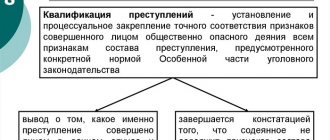Article 162 of the Criminal Code of the Russian Federation speaks of a dangerous criminal act called robbery. This crime in its various forms belongs to the category of grave and especially grave.
Despite the fact that robbery is in the chapter that talks about acts directed against property relations, the theft of property in its composition is by no means the main thing.
The main thing is an attack with the use (or threat) of dangerous violence. What types of robbery has the legislator provided for and what is the penalty for robbery alone or by a group of persons under Article 162 of the Criminal Code of the Russian Federation?
Kinds
By carrying out robbery, a criminal act is committed to forcibly confiscate someone else's property for the purpose of appropriating it.
This process can occur with varying
degrees of cruelty , it is characterized by the manifestation of violence as a result of the illegal seizure of property.
Types of robbery are determined by variety, through a differentiated approach, according to the characteristics of robbery.
Property
Includes the basic characteristics of the crime. The concept of property robbery has the motive of theft, without the use of violence, threats and other aggravating characteristics.
Despite the fact that every robbery implies the possibility of violence under certain circumstances, in such cases it is not used.
As a rule, in this case, criminals look for opportunities without aggravating the nature of the crime.
Attempted robbery
It is defined as part of a crime in the case when a criminal (group) initiated a criminal action that was not carried out for objective reasons.
Minors
For the involvement of minors in a crime of a robbery nature, the organizer of the group will bear additional responsibility, and his criminal status will be determined as qualified .
Often the organizers of organized crime groups involving minors are experienced criminals.
Robbery by an organized crime group is a robbery committed by an organized criminal group.
Armed
A crime with elements of qualification even if no weapon was used. Its presence indicates that the crime was prepared with the degree of acceptance of its use. In such cases, the degree of qualification and possible human casualties depends on the will of chance, which helped to avoid them.
If the robbery with a weapon was carried out using an air pistol, this also aggravates the guilt, due to the fact that the victim, based on the threat with a weapon, will take it seriously.
bodily injuries of varying severity can be taken into account as such .
Simple unskilled
Part 1 of Article 162 describes ordinary robbery without additional aggravating circumstances. Its essence is an attack using violence that is dangerous to life or health (or with the threat of such violence). The purpose of this crime is the theft of someone else's property.
In this case, the criminal acts alone; he does not use weapons or objects that replace them. Property damage as such is not relevant. The theft may not take place at all for one reason or another (for example, the person did not have valuable property on him that the criminal was counting on, or the attacker received a rebuff from the victim himself or third parties). The main thing is that the attack was committed for the purpose of theft, which means that this crime complies with Part 1 of Article 162.
Important. What is an attack? This is an impact on the individual, aggressive and violent. It is possible in both open and hidden forms (for example, a sudden blow from behind).
Situations when an intoxicating, narcotic, toxic substance or drug is introduced into the human body, which leads the person into a helpless state (the person may not even realize that he is being affected by such a drug), are also considered an attack.
However, if a person voluntarily, without coercion, took such a substance, drug (alcohol, drug, etc.), then this is no longer regarded as an attack. A criminal can attack both the owner of the property and a third party (to whom, for example, this property is entrusted, or he is trying to resist the attacker during the attack, etc.).
Dangerous violent acts come in many forms. These are strong blows (for example, with the hands or feet of a criminal), squeezing the victim’s neck in order to intimidate, placing the victim’s head under water (also in order to break resistance and force him to comply with the demands of the raiders) and much more.
Life-threatening violence is actions that pose a real threat to life (even if such consequences do not occur).
Violence dangerous to health is violence that caused slight or moderate harm to a person’s health (even if the consequences did not occur, but at the time of the use of violence there was a risk of such consequences occurring). Violence can also be psychological (threats of murder, grievous bodily harm, etc.).
An example of a robbery from Part 1 of Article 162 could be an attack on a citizen on the street. The criminal inflicts several blows on the victim, strangles him, threatens to kill him and forces him to hand over items of precious metals and money.
Corpus delicti
- The subject is a person who has reached the age of 14 years and is of sound mind.
- The subjective side of robbery is represented by direct intent, the motive of self-interest and a specific goal: to steal someone else's property.
- The immediate objects that are being attacked are the specific form of property + the health of the person being attacked by the criminal.
- The objective side is an attack on a person or organization using violence that poses a danger to life and health (as well as the threat of this violence).
Responsibility
For a criminal who has committed a robbery, qualified under Part 1 of Article 162, the law provides for the following penalties:
- isolation from society in places of deprivation of liberty (MPL) for a period of up to 8 years with a fine of up to 500 thousand rubles or in the amount of the income of the perpetrator for a period of up to 3 years or without this fine;
- or forced labor for up to 5 years.
Most Qualified
That is, the method of appropriating someone else's property is associated with the destruction of the life of the owner of the seized property .
Murder associated with robbery should be classified according to the following categories of this type:
- Road robbery;
- Robbery by a group of persons;
- Robbery committed by a group of persons by prior conspiracy;
- Sea robbery.
The composition and types of crimes can be called classical, since they are rooted in the deep historical past of the social consciousness of mankind. Naturally, in the modern world they have acquired a new color.
Group of persons
Robbery committed by a group of persons by prior agreement (and without it) is the basic prerogative of an organized crime group. They carry out the majority of crimes of this type.
The murders of victims during criminal operations are quite numerous. In the concepts of this type of underworld, the value of human life is not included.
On the roads
Applies to theft of transported property of persons. In such situations, truck drivers often lose their lives on the highway. Also, robbery on the roads is associated with the theft of expensive cars and funds available to drivers.
Sea robbery
Piracy has always been punished with the most severe penalties. Persons who encroached on such a way of life were forever outcasts not only in their own country, but also in friendly countries that were ready to capture and surrender criminals of this type. And this is no coincidence, since maritime robbery enters the arena of global crime. He not only causes property damage through direct robbery.
Maritime robbery blocks the functioning of the most important waterways through which the economic interests of various states are communicated.
Unfortunately, such evil is still ineradicable today. Modern maritime robbery goes beyond property, since the concept, composition and its types simultaneously include the kidnapping of people or their illegal detention, murder, and torture.
Qualifying features
A common feature of robbery and extortion is the appropriation of someone else's property , under the threat of violence or with the use of such.
Unlike other crimes of a property nature, robbery, the use of violence is the most dangerous of all crimes in this category.
Sign of robbery Art. 162 of the Criminal Code of the Russian Federation cannot serve violence that is not based on selfish motives and the goals of taking possession of the property of the victim (group of victims).
The corpus delicti is qualified when it is carried out:
- With the use of weapons or the threat of using weapons;
- By a group of persons by prior agreement (or without it);
- When attracting minors;
- A criminal act that led to the death of the victim ( Qualified murder in the commission of robbery ).
Robbery. Concept. Kinds. Difference from robbery, extortion and banditry. (Article 162)
Concept and types.
Robbery involves an attack for the purpose of stealing someone else's property, committed with the use of violence dangerous to life or health, or with the threat of such violence (Part 1 of Article 162).
This most serious form of theft encroaches on such an additional direct object as the health of the victim, or creates a threat to his life. Main direct object
- ownership. Encroachment on the person is also considered as a means of seizing property.
Victims of robbery may be the owners (possessors), persons in charge of property or guarding it, or other persons not involved in the crime.
Objective side
robbery is described in Article 162 within the framework of the formal corpus delicti and consists of two interrelated acts, one of which (assault) is inherent in all cases of robbery, and the second is alternative and involves either violence dangerous to life or health, or the threat of using such violence.
An assault during robbery is an active and sudden aggressive action for the victim, creating a real danger of immediate and direct use of violence against the person attacked in order to seize the relevant property.
Unlike robbery, which is an open abduction, a robbery attack can be open or invisible to the victims (aiming from an ambush, sneaking up on the victim from behind, attacking a dozing watchman, etc.).
Violence during robbery reaches such a degree that, by its nature or consequences, it poses a danger to life or health. In terms of its consequences, this is violence that resulted in the infliction of grave, moderate or minor harm to health, while harm of moderate severity and minor harm to health is covered by the signs of robbery without qualifying circumstances, and the infliction of grievous harm to health during robbery requires qualification of the act under paragraph “c” Part 4 of this article. Part 1 of Article 162 of the Criminal Code also qualifies an attack committed with the use of violence dangerous to life or health, which, although it did not cause harm to the health of the victim, however, at the time of use created a real danger to his life or health. The introduction into the victim’s body against his will or by deception of potent, poisonous or intoxicating substances dangerous to life or health with the aim of bringing him into a helpless state and taking possession of someone else’s property is also qualified as robbery. In a specific case of robbery committed with the use of a gas canister, for example, the court drew attention to the fact that neither the investigative authorities nor the court found out whether the gas in the canister posed a danger to human life and health. It was necessary to order an examination of the material evidence - a gas canister and ask the experts for permission: what is the effect of the irritating toxic substance contained in the canister on the human body; what is the severity of bodily injury that may result from the use of this gas.
If violence during robbery was accompanied by murder or, as a result of causing grievous bodily harm due to negligence, the death of the victim occurred, then what was done, in addition to paragraph “c” of part 4 of Article 162, needs to be qualified under paragraph “h” of part 2 of Article 105 or part 4 of Article 111.
The “threat of violence” in Part 1 of Article 162 of the Criminal Code in practice and theory is understood as a threat of torture, causing harm to (any) health of the victim, as well as murder.
The threat of violence can be of a definite nature, when the subject directly declares the intention to take the victim’s life or cause harm to his health, or it can be vague (“I’ll show you,” “it will be worse,” etc.). In the latter case, when assessing the content and direction of the threat, all circumstances of the case should be taken into account, in particular the place and time of the robbery, the number of criminals, the nature of the objects with which they threatened, the subjective perception of the threat to the victims, etc.
By design, the corpus delicti of robbery, in contrast to the corpus delicti provided for in Articles 158 - 161 of the Criminal Code, is formal. Robbery is recognized as a completed crime from the moment of an attack involving violence or the threat of violence, regardless of whether the perpetrator managed to seize the relevant property. However, if such a seizure turns out to be successful (and this usually happens), then it is certainly included in the structure of the objective side of the crime.
Subjective side
. Expressed literally. The intent of the guilty subject covers the method of the crime he commits. Doubling the goal: a selfish goal is added to the theft.
Subject
robbery may be a sane person who has reached the age of 14.
Part 2 of Article 162 provides for the qualifying signs of robbery:
— committed by a group of persons by prior conspiracy;
- using weapons or objects used as weapons.
An agreement to use violence against the victim that is dangerous to life or health must take place before the commission of the crime. Otherwise, the person should be held responsible only for his specific actions.
For example, if a group of persons, by prior conspiracy, had the intention to commit robbery (or theft), and one of the participants used or threatened to use violence dangerous to the life or health of the victim, then his actions should be qualified as robbery, and the actions of other persons - accordingly, as robbery (or theft) provided that they did not directly contribute to the use of violence or did not use it to take possession of the victim’s property.
When qualifying the actions of the perpetrator as robbery committed with the use of weapons or objects used as weapons, in accordance with Federal Law No. 150-FZ “On Weapons” and on the basis of an expert opinion, it is established whether the object used in the attack is a weapon intended for hitting a living or other target. In accordance with this law: weapons are objects or devices structurally designed to hit a living or other target and send signals.
Such robbery occurs if the subject uses weapons in the proper sense of the word (firearms, cold steel, gas, throwing, muscular, pneumatic) or other objects used as weapons. “Other objects” used as weapons should be understood as objects that could cause bodily harm to the victim that are dangerous to life or health (a penknife or kitchen knife, a razor, an ax, a crowbar, a baton, a rocket launcher), as well as objects intended to temporarily defeat a target (mechanical sprays, aerosols and other devices filled with tear and irritant substances), regardless of whether they are prepared by the subject in advance or picked up at the crime scene.
If the perpetrator had a weapon illegally, then his actions are subject to additional qualification under Article 222 or 223. However, the presence of weapons or other objects in the person’s possession is not enough to assess his actions under Part 2 of Article 162, and their use must be used as a means of life-threatening violence or health, or a weapon that supports the threat of violence. Influence is also understood as an attempt to cause damage to the victim with these objects, as well as a demonstration to the victim or third parties of a readiness to use them. If the perpetrator only demonstrated a weapon or threatened with a obviously unusable weapon or an unloaded weapon or an imitation weapon (for example, a dummy pistol, a toy dagger), without intending to use these objects to cause bodily harm dangerous to life or health, his actions (in the absence of other aggravating circumstances ), taking into account the specific circumstances of the case, should be classified under Part 1 of Article 162 of the Criminal Code (however, it is possible to qualify the act as robbery if the victim understood that he was being threatened with an unusable or unloaded weapon or an imitation weapon).
In cases where the intent of the perpetrators who committed a robbery by a group of persons by prior conspiracy included the use of weapons (or objects used as weapons), all participants in the crime committed are liable as co-principals even in the case where the weapon (or objects used as weapons) as a weapon) were used by one of them.
According to the qualifying criteria under consideration, taking into account the specific circumstances of the case, persons who committed an attack with the aim of stealing someone else's property using dogs or other animals that pose a danger to human life or health, or with the threat of using such violence, are also liable.
Part 3 of Article 162 establishes liability for robbery committed:
- with illegal entry into a home, premises or other storage;
- on a large scale.
The content of these signs coincides with the signs of the forms of theft discussed above (in particular, theft).
And in part 4 - for robbery committed:
— an organized group;
- for the purpose of seizing property on a particularly large scale;
- causing serious harm to health.
Clause “c” of Part 4 of Article 162 of the Criminal Code (robbery committed with infliction of grievous harm to the health of the victim) is applied if the actual violence used resulted in the infliction of grievous harm to the health of the victim. There must be direct intent to cause serious harm. Additional qualification under Article 111 of the Criminal Code is not required, with the exception of the death of the victim due to negligence. In this case, what the perpetrator did will be qualified under paragraph “c” of Part 4 of Article 162 and Part 4 of Article 111 of the Criminal Code. It does not matter for qualification when grievous harm to the victim’s health is caused: at the time of taking possession of property, during his resistance, or after taking possession for the purpose of retention.
If the perpetrator commits murder during a robbery, then what he has done should also be qualified under paragraph “c” of Part 4 of Article 162 of the Criminal Code and additionally paragraph “h” of Part 2 of Article 105 of the Criminal Code.
The Resolution of the Plenum of the Supreme Court of the Russian Federation “On judicial practice in cases of theft, robbery and robbery” mentions the development of theft, begun in a different form, into robbery.
- firstly, theft in another form was still at the attempted stage, when the subject had not yet managed to seize someone else’s property or had already made such a seizure, but had not acquired a real opportunity to use or dispose of it at his own discretion;
- secondly, all other forms of theft can develop into robbery, including incomplete fraud (Article 159) and misappropriation or embezzlement (Article 160). This possibility is due to the fact that theft in other forms has a length of time necessary to extract property from the owner (possessor) and turn it into the property of individual unauthorized persons. In cases where citizens prevent this, overcoming their opposition can be achieved by violence or threats described in Article 162;
- thirdly, actions begun as robbery are characterized by an act of attack. If the theft is started in a different form, then its first stage is not an attack, but other actions provided for in Articles 158 - 161, and only then these actions are modified, becoming violent and dangerous to life or health;
- fourthly, when theft begins as robbery, violence or threat is used for the purpose of criminal seizure of someone else’s property, and in cases of other forms of theft escalating into robbery, these aggressive actions are aimed at taking possession of the stolen property values or retaining them immediately after possession and have the opportunity to dispose of them at their own discretion.
The act described in parts 1 and 2 of Article 162 belongs to the category of grave crimes, and in parts 3 and 4 - especially grave ones.
Difference from robbery, extortion and banditry.
Robbery should be distinguished from robbery committed with violence by the method of violation of property relations: robbery differs from robbery in that in robbery the theft of someone else's property occurs with the use of violence or the threat of violence that is not dangerous to life or health, and in robbery such violence or the threat of its use is dangerous to life or health. Signs of such violence are discussed above. There are also differences in the design of the objective side: robbery, combined with violence that is not dangerous to the life or health of the victim, has a material structure, that is, the crime will be considered completed from the moment when the perpetrator took possession of the property and received a real opportunity to use and dispose of it, and robbery is a formal (truncated) construction of the crime, that is, the crime is considered completed from the moment of the use of violence or the threat of violence for the purpose of direct seizure of property, regardless of the criminal result.
Robbery should be distinguished from extortion by the following characteristics:
- according to the subject of the crime: the subject of extortion can be property, the right to property or the commission of actions of a property nature, and the subject of robbery can only be property;
- by the nature of violence: in extortion, violence is manifested in the threat of physical violence, the threat of destruction, damage to property or dissemination of information, as well as the use of physical violence; in robbery, violence consists of the use of physical violence or the threat of violence dangerous to life or health;
- on the objective side: with extortion, violence or the threat of its use is aimed at obtaining property in the future; in some cases, extortion may consist of presenting a demand to the victim for the immediate transfer of property under the threat of using violence in the future.
The question of distinguishing between robbery and banditry arises in cases where robbery is committed by two or more persons using weapons (although robbery can be committed by one person, and banditry is always an association of two or more persons). The most important condition for distinguishing the concepts of robbery and banditry is to understand the signs that characterize a gang. A gang is an armed group of people created for attacks. Common features with robbery are armament and purpose. Moreover, in robbery the sign of armament is broader than in banditry. A gang can only be armed with items that are classified as weapons under federal law. A preliminary conspiracy of persons who have committed robbery occurs, as a rule, shortly before the commission of a crime, due to which this group cannot be recognized as cohesive, stable and highly organized.
The objects of crime for robbery and banditry are different: the direct object of robbery is property relations; the direct object of banditry is public security relations; and objective aspects: robbery consists of the use of violence or the threat of violence, dangerous to life or health, with the aim of directly taking possession of property; banditry - forming a gang, or leading a gang, or participating in a gang or attacks committed by a gang.
Robbery is a deliberate crime committed for mercenary purposes, and with banditry, the goal is attacks on enterprises, institutions, organizations or citizens.
If criminal liability for banditry begins according to the general rule, that is, from the age of 16, then for robbery the age of criminal liability has been reduced to 14 years.
Qualification Features
Robbery is not classified in relation to property damage caused.
Other crimes of a property nature have the following qualification :
- General damage;
- State;
- To a private person;
- Legal entity.
This point is due to the fact that in relation to countering this type of crime, the priority is the principle of the structural organization of the criminal community. At the same time, the most important element is the value of human life , which is endangered in the process of carrying out robberies.





